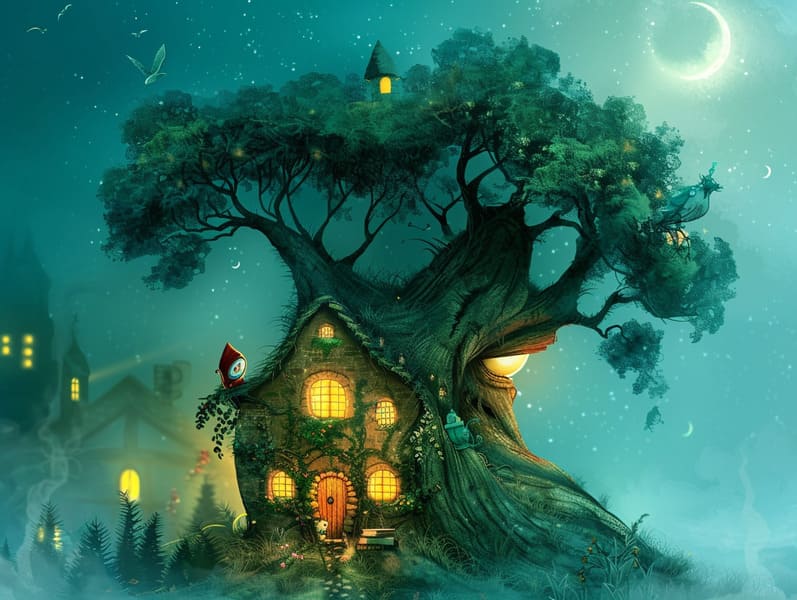
Best fairy tales have deep roots. These stories have been recounted from one generation to the next ages before they were ever written down. They arose from a variety of civilizations, including Asian traditions. They were initially told among elders, often carrying themes and messages relevant to the societal norms and beliefs of the time.
The Brothers Grimm, Jacob and Wilhelm (the Grimm brothers), were among the first to compile and release many of these beloved stories. Their volume, "Grimm's Fairy Tales," included stories like "The Story of Cinderella," "The Bread Crumb Trail," and "Schneewittchen," which have since become hallmarks in the world of beloved fairy tales. Similarly, Andersen's charming tales, such as "The Mermaid's Tale," and "The Little Duckling," have floated into hearts worldwide, establishing their place in the pantheon of treasured fairy tales.
Despite their historical roots, classic fairy tales remain as pertinent as ever, especially as kids' bedtime tales. These fantastical tales are now available in different formats, including colorful picture books, fantastical animations, and internet fairy tales.
Their continued relevance can be connected to several magical reasons:
Valuable Lessons: Timeless fairy tales often offer important moral lessons. Fairy tales like "The Boy Who Cried Wolf" teach the virtue of being truthful, while "The Tortoise and the Hare" demonstrate the benefits of persistence and humbleness. These stories offer little ones clear distinctions between right and wrong, helping to shape their moral compass in a soft yet significant way.
Sympathy and Perception: Classic fairy tales frequently showcase heroines facing struggles and tests, provoking audiences to understand with their struggles and cheer for their triumphs. For instance, "Beauty and Her Beast" illustrates the importance of seeing beyond the surface to comprehend the real person of a individual, nurturing understanding and recognition.
Cultural Understanding: Many timeless fairy tales are rooted in the cultural contexts from which they developed. Delving into these stories can provide enlightening views into different backgrounds, cultivating a sense of world understanding and comprehension.
Inventiveness and Imagination: The supernatural elements in ancient fairy tales—enchanted lands—fuel children’s visions and dreams. These narratives take readers to imaginary realms, promoting imaginative dreams and a sense of enchantment that stays a lifetime.
Classic fairy tales are not only delightful but also illuminating. They serve as entrancing tools in advancing various mind and heart abilities in children. When old fairy tales are spoken, they nurture language skills by presenting new vocabulary and complicated sentence structures. This practice also develops auditory skills and attention, as children listen intently, anxious to see what happens next.
Furthermore, analyzing the themes and characters of timeless fairy tales can develop analytical skills and intellectual skills. The young learn to detect patterns, guess what will happen, and grasp cause and effect. These examinations also facilitate young ones say their thoughts and feelings, boosting their emotional intelligence.
In today’s technological era, the presence of free fairy tales online has made these tales more accessible than ever. Online platforms and web apps give comprehensive collections of popular fairy tales that can be perused or heard anytime, anywhere. Fairy tales read out loud are particularly well-liked, supplying an immersive method for kids to engage with these charming stories. Sound books and voiced videos take characters and settings to life, often accompanied by captivating music and instrumentals that improve the narrative check it out experience.
The timeless appeal of ancient fairy tales lies in their ability to shift to present eras while keeping their underlying messages. Contemporary revisions of these tales often present more different protagonists and modern settings, making them relatable to today’s audience. However, the main ideas of boldness, generosity, and equity remain unchanged, continuing to reach readers of all ages.
Ancient fairy tales also offer a sense of warmth and comprehensibility. They impart upon a well-ordered narrative with a transparent beginning, middle, and end, often coming to a close with the resolution of conflicts and the triumph of rightness over wrongness. This foreseeability can be consoling for children, offering a sense of sturdiness in an ever-changing world.
Traditional fairy tales continue to enchant and teach new generations, maintaining their appeal and applicability in modern society. As nighttime stories for kids, they confer upon a perfect blend of charm and enlightenment, cultivating moral values, empathy, and creativity. The existence of internet fairy tales and the well-received status of fairy tales voiced secure that these ancient stories remain accessible to new generations.
By conserving and sharing these stories, we continue to esteem the rich tapestry of inventiveness and cultural heritage. Whether you are perusing a richly illustrated book, seeing a cyber library, or listening through an read-aloud story, the radiance of traditional fairy tales is always within reach. These tales highlight of the ageless spell of tales and its ability to connect us across eras and regions.
If you are viewing a vibrantly illustrated book, discovering a electronic collection, or listening on an audiobook, the loveliness of classic fairy tales is always within reach.
These stories remind us of the immortal essence of tales and its ability to hold us together across generations and cultures, making a tie that enchants and educates alike.
Comments on “The Start of Bedtime Fairy Tales with the Unchanging Wonder.”